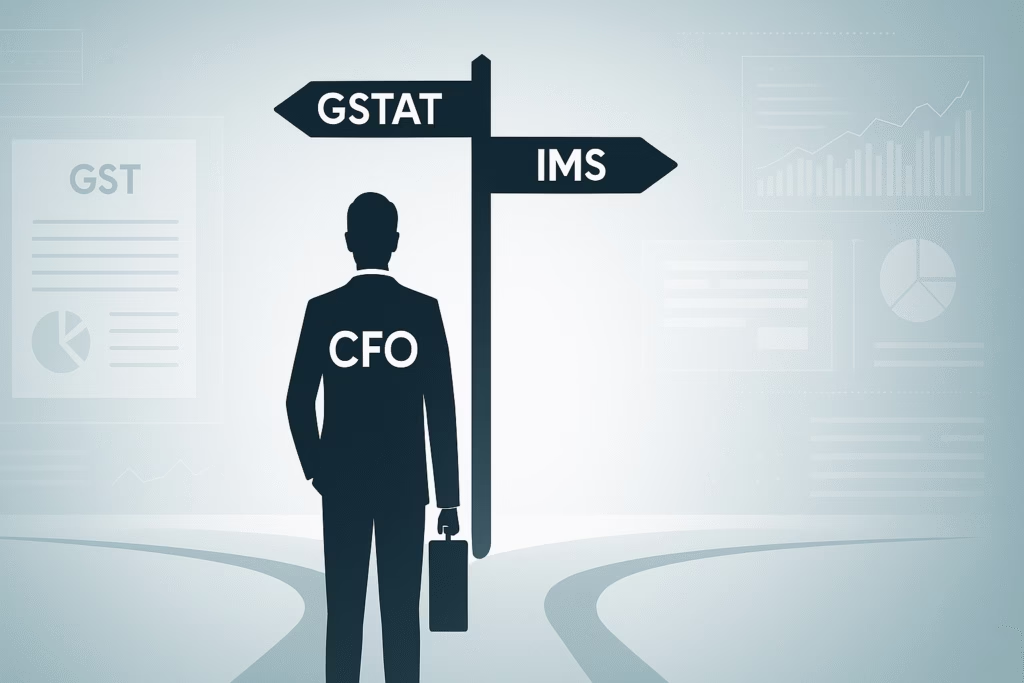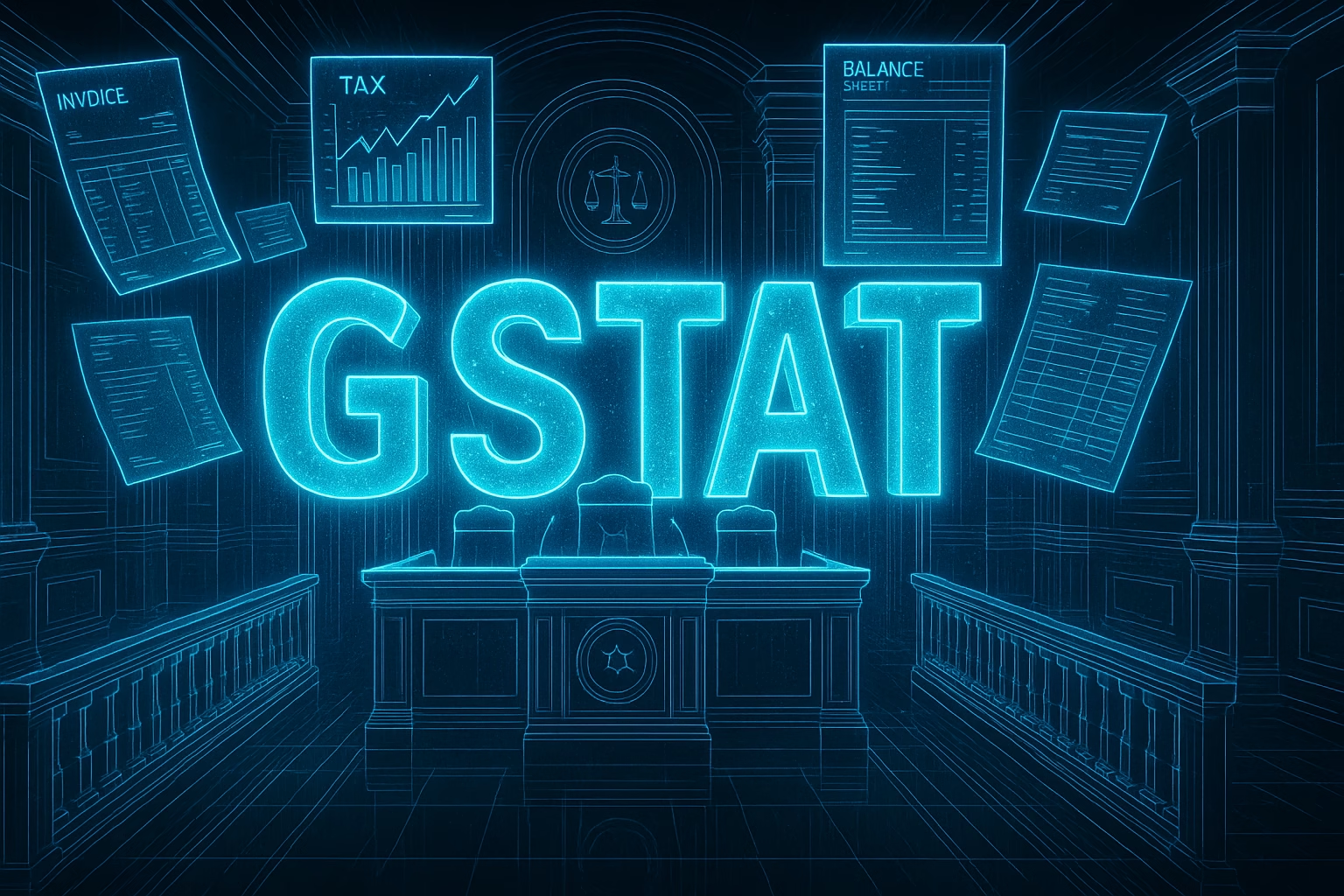If you’re a CFO or compliance head, 2025 isn’t giving you the luxury of waiting. Three big reforms—rate rationalisation, the IMS rollout, and the long-awaited GSTAT—are all hitting at once. The message is clear: the way you price, claim ITC, and fight disputes is about to change dramatically.
This quarter isn’t about passive tracking; it’s about preparing your teams before gaps turn into costly notices. In the next few minutes, you’ll find a practical checklist—what to fix, what to test, and what to monitor—so you walk into Q2 with fewer surprises and stronger control.
What is IMS under GST?
IMS (Invoice Management System) is a government-provided platform that allows taxpayers to accept, reject, or keep supplier invoices pending. These actions directly influence GSTR-2B auto-populated ITC data and ensure cleaner reconciliation with GSTR-3B. It is being rolled out in 2025 to reduce mismatches, strengthen ITC discipline, and improve vendor compliance visibility.
What is GSTAT?
GSTAT (Goods and Services Tax Appellate Tribunal) is a dedicated appellate body created to resolve GST disputes. It provides a structured forum between the first appeal stage and High Courts, with benches, filing protocols, and reduced timelines. From 2025, GSTAT will handle appeals related to classification, ITC eligibility, valuation, and demand disputes, helping businesses avoid lengthy High Court litigation.
We covered in detail about What Is GST Compliance & How to Stay 100% Compliant in 2025– In our previous blog here!
What’s Changing in 2025—At a Glance
-
Rate rationalisation: Expect a simplified structure—likely two or three slabs—with items currently under 12% and 28% moving into adjacent categories.
-
IMS rollout: Invoice acceptance and rejection workflows will reshape how GSTR-2B is populated, reducing mismatches and tightening links with GSTR-3B.
-
GSTAT activation: Dedicated appellate tribunals are being stood up with new filing protocols and faster timelines compared to High Courts.
What Rate Rationalisation Could Mean for Pricing, ITC, and Forecasting
Pricing scenarios
-
Scenario 1: Essentials move from 12% → 5%: margin structures shift, but price sensitivity improves.
-
Scenario 2: Consumer durables move from 28% → 18%: significant reworking of catalogues and dealer margins.
-
Scenario 3: Select services move upward into 18%: cost pass-through vs. margin absorption analysis needed.
Action: Keep pre- and post-tax price ladders ready. Plan for re-stickering, catalog updates, ERP resets, and dealer communications.
ITC implications
- Re-map HSNs into new slabs before notifications land.
- Run ITC availability simulations to forecast working capital impact.
- Update ERP tax codes, POS systems, and logistics invoices quickly when rates change.

IMS Playbook—From Pilot to BAU in 60 Days
Configure and align
- Ensure e-invoicing compliance (IRP connectivity, thresholds).
- Clean supplier master data (valid GSTINs, filing frequency, status).
- Turn on IMS workflows: Accept/Reject/Pending with clear SLAs.
Daily/weekly cadence
-
Daily: Fetch supplier invoices, auto-suggest action, escalate anomalies.
-
Weekly: Reconcile GSTR-2B with purchase register, follow up with vendors, and track deemed-acceptance risk.
Exception library
Typical IMS exceptions:
- Vendor non-filing
- Wrong GSTIN
- Duplicate invoice
- Missing IRN
- Tax mismatch
- HSN code conflict
- Abnormal ITC claim vs. revenue
Action: Define owner, turnaround time, and resolution steps for each; automate ticketing.
Prepare for GSTR-3B “locking”
- Move toward sourcing 3B values directly from IMS/2B with minimal overrides.
- Maintain an override register with justification, approvals, and reversal process.
Want to see how IMS readiness looks in practice? Our GST Analysis tool runs supplier GSTIN checks and 2B reconciliations in minutes.
GSTAT Readiness—Shortening the Path from Notice to Order
Documentation spine
- Maintain e-invoice archives, IMS logs, reconciliation reports, vendor compliance evidence, and classification notes.
- Build a standard “case pack” with facts, grounds, computations, exhibits, and chronology.
Pre-deposit and timelines
- Train finance teams on pre-deposit rules.
- Maintain a litigation calendar: appeal windows, cause-list monitoring, interim relief updates.
Role clarity
- Assign a litigation coordinator.
- Set counsel engagement SOPs.
- Train staff on evidence standards for ITC, valuation, and classification disputes.
Building a case pack is easier when your data is already organised. Pro Analyser’s GST Analyser exports case-ready reconciliation and notice evidence in one click.
Vendor Compliance = ITC Protection
Build a vendor risk score
Inputs:
- GSTIN status
- Filing regularity
- Cancellation risk
- Mismatch history
- E-invoice adoption
- Sector norms
Use the score to set PO limits, advance payment rules, and IMS action strictness.
Contractual levers
- Insert ITC indemnity clauses.
- Define cure periods and require periodic compliance certificates.
- Conduct quarterly vendor reviews tied to risk scores.
Protecting ITC starts with vendor hygiene. Use GST Analyzer to track filing regularity, cancellation risks, and mismatches before they hit your books.
30-60-90 Day Roadmap
0–30 days
- Pilot IMS on top 20 vendors.
- Reconcile past 2 months’ data.
- Build an exception library and SLA.
- Draft litigation pack template.
31–60 days
- Expand IMS to 80% vendor volume.
- Conduct weekly 2B reconciliation.
- Run pricing/ITC scenario analysis.
- Deploy vendor risk scoring.
61–90 days
- Shift 3B to source-locked mode.
- Automate GST notice inbox.
- Dry-run a GSTAT case pack.
- Finalize all playbooks.
FAQs
Rate changes may shift products or services into higher or lower slabs, directly affecting margins and selling prices. Companies should prepare price ladders with pre- and post-tax values and update ERP, catalogues, and dealer communication in advance.
Ensure supplier GSTIN master data is clean, configure Accept/Reject/Pending workflows, and reconcile GSTR-2B with purchase registers weekly. Companies should also set SLAs for invoice actions to avoid deemed acceptance.
GSTAT provides a faster appellate forum than High Courts, with defined procedures, benches, and timelines. It is designed to streamline disputes on ITC, valuation, classification, and demands.
Maintain a litigation-ready “case pack” that includes e-invoice archives, reconciliation records, vendor compliance logs, and classification notes. Finance teams must also budget for pre-deposits and track filing deadlines.
Use vendor risk scores based on GSTIN status, filing behaviour, cancellation risk, and mismatch history. Tie vendor reviews, payment terms, and contract clauses to this score for stronger ITC protection.
Takeaway:
This quarter is about translating GST reform headlines into SOPs and checklists. Rate rationalisation, IMS, and GSTAT are not abstract policy—they’re operational triggers. CFOs and compliance leaders who act now will protect ITC, reduce disputes, and steer clear of notice-driven firefighting.
👉 Start with an IMS readiness check using Pro Analyser’s GST Analysis tool today.
Source References:
Official Websites
- Ministry of Finance – GST Notifications and Circulars: https://finmin.nic.in/
- CBIC – GST & e‑invoicing updates, advisories, FAQs: https://cbic-gst.gov.in/
- GST Council – Council updates and decisions: https://www.gstcouncil.gov.in/
- GSTN – Portal advisories, IMS/GSTR-2B/3B information: https://www.gst.gov.in/
- GST Appellate Tribunal (GSTAT) – Official site: https://www.india.gov.in/website-gst-appellate-tribunal
- GSTN – GSTAT Application page: https://gstn.org.in/gstat-application/
- Department of Revenue (DOR) – GSTAT recruitment/notifications: https://dor.gov.in/
IMS (Invoice Management System) Resources
- GST Portal Advisory – Invoice Management System (PDF): https://tutorial.gst.gov.in/downloads/news/revised_advisory_on_ims.pdf
- ClearTax – What is Invoice Management System (IMS) under GST: https://cleartax.in/s/invoice-management-system-ims-under-gst
- ClearTax – IMS Timelines/Key Dates: https://cleartax.in/s/ims-in-gst-timelines-dates
GSTAT Procedures and Updates
- PwC India – Booklet on the GSTAT (Procedure) Rules, 2025: https://www.pwc.in/ghost-templates/booklet-gstat-procedure-rules-2025.html
- CAalley – Government notifies rules for GST appellate tribunals: https://www.caalley.com/news-updates/indian-news/government-notifies-rules-for-gst-appellate-tribunals
Rate Rationalisation and Market Impact (News/Analysis)
- Reuters – Explainer on GST reform and price impact: https://www.reuters.com/world/india/indias-complex-gst-tax-how-modis-reform-will-make-goods-cheaper-2025-08-19/
- CNBC-TV18 – Two-rate GST reform proposal coverage: https://www.cnbctv18.com/economy/india-proposes-gst-reforms-two-rate-structure-new-40-pc-slab-for-sin-goods-ws-l-19655461.htm
- Times of India – Demand/consumption impact commentary: https://timesofindia.indiatimes.com/business/india-business/gst-revamp-indias-new-regime-to-lift-demand-consumption-heres-what-morgan-stanley-says/articleshow/123361148.cms
- NDTV Auto – GST reforms and auto industry implications: https://www.ndtv.com/auto/gst-reforms-2025-what-a-tax-cut-on-vehicles-means-for-indias-auto-industry-9114008



